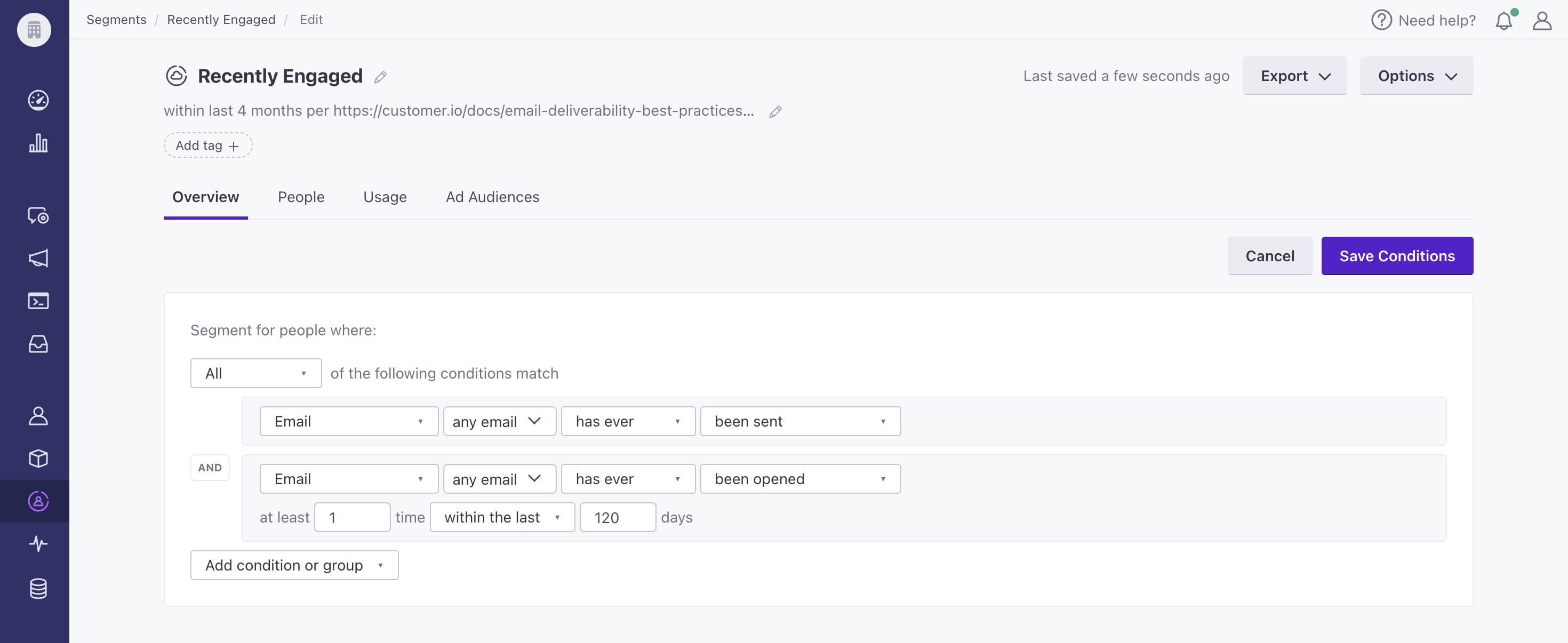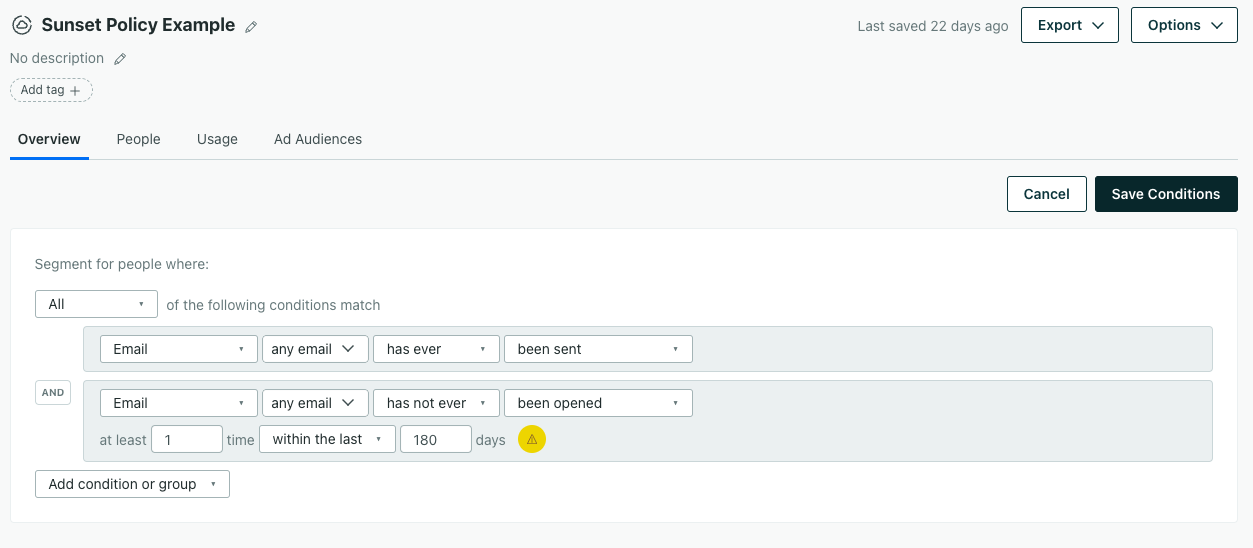Email Deliverability Best Practices
UpdatedWhat is email deliverability?
Email deliverability is whether or not the emails you are sending are reaching the inbox of your recipients. There are a number of factors that can directly influence whether or not your emails arrive in the inbox. All of these best practice guidelines should be addressed to ensure maximum deliverability.
Deliverability factors
Technical Setup
Configuring your MX, DKIM and SPF records is the most important step in letting inbox providers know that Customer.io is authorized to send email for your domain. These records are configured in your account under Workspace Settings > Email > Sending Domains. Check out our documentation on authenticating domains in Customer.io to learn more!


Spam and Complaint Rates
It’s always a good idea to keep an eye on complaint rates. Any complaint rate in excess of 0.10% may result in damage to your sender reputation at both the IP and Domain levels. Increased spam rates over a short period of time can also lead to increased filtration, reduced delivery speed, throttling, or bounces.
How to decrease spam rates
Unlike technical or engagement factors, reducing spam rates has a simple solution: Send email that people both desire and expect to receive that is relevant to their relationship with your brand. To decrease spam rates, we recommend taking all of the following actions:
- Think about how your sending relationship with a recipient was started. Were messaging expectations set at any point? Have you clearly outlined to a person who uses your services that you will send email? When a person doesn’t expect an email, they are much less likely to open it, and by extension, more likely to flag it as spam.
- When you first start a new campaign or chain of marketing newsletters for a new sign up, it’s best to remind the recipient why they are receiving a given email.
- Ensure that the branding of your emails is consistent. If a recipient signs up for a product or service on your website, make sure that your email domains and email branding align with what the recipient has seen so far and on your sign up page. If you send an email from a brand or domain the recipient doesn’t recognize, it can increase the likelihood that the recipient will mark it as spam.
Denylists
Denylistings can have an impact on your inbox placement for the duration of the denylisting. We monitor all of the shared and dedicated IPs that we control for denylisting activity and work to mitigate these listings whenever we can.
Bounces
Bounces can occur for a variety of reasons, some technical, some reputation-based. With that in mind, a large number of bounces caused by sending to non-existent or inactive email accounts can definitely reduce your sender reputation with inbox providers and result in increased filtering to the spam folder. We recommend keeping your overall bounce percentage under 5%. Keeping this value lower than 2% is ideal. Follow best practices under List Health to reduce bounces.
Do not migrate hard bounced recipients
If you are migrating to Customer.io from another platform, be sure to omit any recipients who have previously hard bounced (email was permanently rejected) to avoid a high number of bounces on Customer.io.
Volume
Sending at a consistent rate over time can reduce the impact that larger sends can have on your reputation. For example, if you are sending a single large newsletter once per month, think of ways to break that information up into smaller, more-targeted drip campaigns.
Volume has two primary considerations:
- Overall volume
- Sender-specific volume
For example, Gmail will get a sense of a given sender’s volume over time and utilize this benchmark as the foundation for what their expected volume should be. If you notice a decline in your open rates (or click rates if you disabled open tracking), try reducing your sending volume to individual recipients.
IP and Domain Reputation
Inbox providers use either the IP reputation or your domain reputation as the unique identifier for a sender. (Some inbox providers, like Gmail, track reputation with both.)
- IP Reputation: This represents the reputation designation for a given IP address. At Customer.io, this may represent the reputation of our shared IPs or any dedicated IPs that have been assigned to your account.
- Domain Reputation: This represents the reputation rating for all sending from a given domain. Your domain reputation can be influenced by the domain in your from address (Primary) and by the complaint rates of emails that include your domain in any links.
A low IP or domain reputation is the most common reason that a given email might be filtered to spam.
You can check the reputation of your sending domain (cio#####.<your-domain>.com) with tools like MxToolBox. To find your sending domain, go to Settings > Workspace Settings > Email > Sending Domains. Click Show Records, copy the host name and prepend to your domain.
List Health
Maintaining a list of engaged and active subscribers is essential to your email success. With that in mind, we recommend focusing on the following:
Double Opt-in
We advise all senders to verify any email address that is imported into Customer.io prior to sending email messages to them. Inbox providers are becoming increasingly strict in this regard. By verifying that the email addresses are correct through double opt-in, you can ensure that the contact information your recipients provide is valid and current. This will minimize the reputation damage that can arise from high bounce levels and low engagement. If you do not currently have a double opt-in mechanism in place, you can create a campaign to achieve this in Customer.io. Check out our recipe for building a double opt-in campaign within Customer.io.
Filter on Engagement
All non-transactional email audiences should be limited to only those recipients who have opened or clicked an email in the last 4 months to be considered engaged by the standards of major inbox providers like Gmail and Microsoft. Your own subscriber behavior and sending frequency can also influence this time frame. You can create a segment that matches only engaged recipients like this:


Sunset Policy
Are you removing people from your lists after a long period of no engagement? For example, anyone who hasn’t opened or clicked an email in the last 6 months should be removed from all non-transactional campaigns or newsletter audiences.
To do this in Customer.io, you can identify inactive recipients by creating a segment that matches only people who have been sent emails in the last 6 months, but haven’t opened any of them. For better results, you could decrease the timeframe from 6 months to 5 months.
The following image shows what such a segment configuration might look like:


Industry-specific engagement criteria will vary from business to business so the exact sunset criteria you adopt is entirely up to you. The goal here is to ensure that you have established a plan for removing recipients from your lists if they don’t engage or respond to re-engagement attempts.
Unsubscribes
Including an unsubscribe link in your emails is one of the cornerstones of modern deliverability best practices. All recipients should have the option to unsubscribe from your email whenever they choose to via an unsubscribe link (usually placed at the footer of an email). In addition to offering unsubscribes, it is of the utmost importance that people who have unsubscribed stop receiving your emails.
At Customer.io, we make this part of the equation easy. Check out the documentation on our built-in unsubscribe functionality and subscription center to learn more.
Content
Spam filters are better than ever at recognizing spam content in an email. Most major providers will compare a given email to other emails that have received high complaint rates. By personalizing your content and ensuring that your emails are relevant to your recipients’ relationship with your brand, you can avoid potential filtering caused by sending content that is deemed spammy.
Don’t underestimate your sender reputation
The landscape of email deliverability has changed a lot in the last few years. While your email content is a major factor, inbox providers heavily weigh your individual sender reputation when analyzing the content of a given message. Content scanning is primarily designed to identify phishing attempts or other unwanted email.
With that said, here are a few general guidelines:
- Spammy subject lines and content: LOTS OF CAPITAL LETTERS, dollar signs or emojis. Use your best judgment here.
- Content relevance to the audience: Are you sending email about topics your recipients will look forward to reading? More importantly, are your recipients expecting an email from you?
- Image to text ratio: Ideally, aim for an image to text ratio with images no more than 40% of the content. Content that only contains images will generally perform very poorly with Gmail’s content filter. We also suggest not having content with a large number of CTAs (‘calls to action’ like buttons or links). The main CTA should be above the fold (visible on-screen when first opened) and we say no more than 3 to 4 calls to action total should be in the content. The ReallyGoodEmails website has some really strong examples of good email content. We recommend looking there for examples that are similar to what you’re planning to send in order to get some ideas and guidance.
- Mobile-friendly content: Use responsive/mobile-friendly code.
- URL Shorteners: Avoid them at all costs. These are commonly used by spammers to hide malicious links, so inbox providers will very likely filter emails with shortened links in the body.

